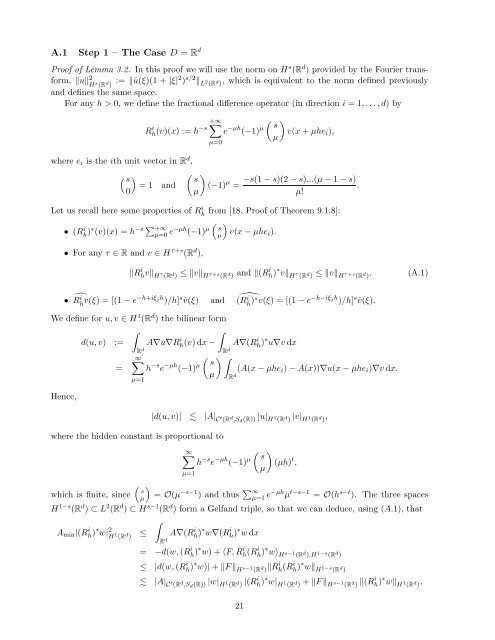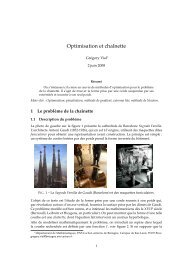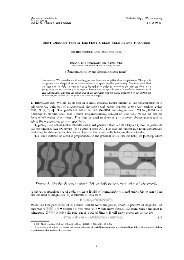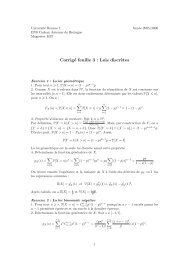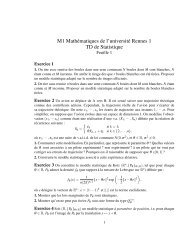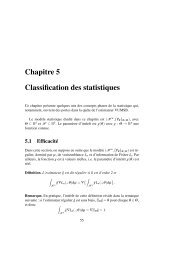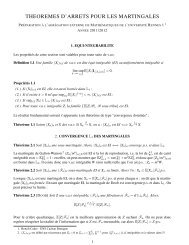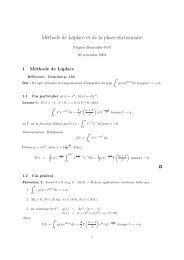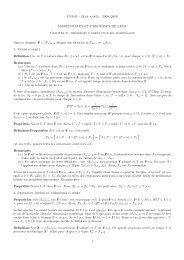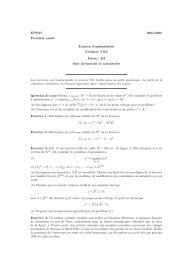Bath Institute For Complex Systems - ENS de Cachan - Antenne de ...
Bath Institute For Complex Systems - ENS de Cachan - Antenne de ...
Bath Institute For Complex Systems - ENS de Cachan - Antenne de ...
Create successful ePaper yourself
Turn your PDF publications into a flip-book with our unique Google optimized e-Paper software.
A.1 Step 1 – The Case D = R dProof of Lemma 3.2. In this proof we will use the norm on H s (R d ) provi<strong>de</strong>d by the Fourier transform,‖u‖ 2 H s (R d ) := ‖û(ξ)(1 + |ξ|2 ) s/2 ‖ L 2 (R d ), which is equivalent to the norm <strong>de</strong>fined previouslyand <strong>de</strong>fines the same space.<strong>For</strong> any h > 0, we <strong>de</strong>fine the fractional difference operator (in direction i = 1, . . . , d) bywhere e i is the ith unit vector in R d ,Rh i (v)(x) := ∑+∞ ( ) s h−s e −µh (−1) µ v(x + µhe i ),µ( s= 1 and0)µ=0( sµ)(−1) µ =−s(1 − s)(2 − s)...(µ − 1 − s).µ!Let us recall here some properties of Rh i from [18, Proof of Theorem 9.1.8]:• (Rh i )∗ (v)(x) = h −s ∑ ( )+∞µ=0 e−µh (−1) µ sµv(x − µhe i ).• <strong>For</strong> any τ ∈ R and v ∈ H τ+s (R d ),‖R i h v‖ H τ (R d ) ≤ ‖v‖ H τ+s (R d ) and ‖(R i h )∗ v‖ H τ (R d ) ≤ ‖v‖ H τ+s (R d ).(A.1)• ̂R i h v(ξ) = [(1 − e−h+iξ jh )/h] sˆv(ξ) and ̂ (Rih) ∗ v(ξ) = [(1 − e −h−iξ jh )/h] sˆv(ξ).We <strong>de</strong>fine for u, v ∈ H 1 (R d ) the bilinear form∫d(u, v) := A∇u∇Rh ∫R i (v) dx − A∇(Rh i )∗ u∇v dxd R∞∑( ) ∫ds= h −s e −µh (−1) µ (A(x − µhe i ) − A(x))∇u(x − µhe i )∇v dx.µ R dHence,µ=1where the hid<strong>de</strong>n constant is proportional to|d(u, v)| |A| C t (R d ,S d (R)) |u| H 1 (R d ) |v| H 1 (R d ),∞∑( ) sh −s e −µh (−1) µ (µh) t ,µµ=1(which is finite, since sµ)= O(µ −s−1 ) and thus ∑ ∞µ=1 e−µh µ t−s−1 = O(h s−t ). The three spacesH 1−s (R d ) ⊂ L 2 (R d ) ⊂ H s−1 (R d ) form a Gelfand triple, so that we can <strong>de</strong>duce, using (A.1), that∫A min |(Rh i )∗ w| 2 H 1 (R d )≤ A∇(Rh i )∗ w∇(Rh i )∗ w dxR d= −d(w, (R i h )∗ w) + 〈F, R i h (Ri h )∗ w〉 H s−1 (R d ),H 1−s (R d )≤ |d(w, (R i h )∗ w)| + ‖F ‖ H s−1 (R d )‖R i h (Ri h )∗ w‖ H 1−s (R d ) |A| C t (R d ,S d (R)) |w| H 1 (R d ) |(R i h )∗ w| H 1 (R d ) + ‖F ‖ H s−1 (R d ) ‖(R i h )∗ w‖ H 1 (R d ),21


